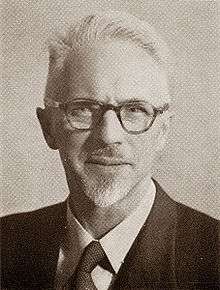Albert Hertzog
| Dr Albert Hertzog | |
|---|---|
 | |
| Minister of Health | |
|
In office 24 August 1954 – 24 August 1958 | |
| Monarch | Queen Elizabeth II |
| Governor General | Ernest George Jansen |
| Prime Minister | Hendrik Verwoerd |
| Preceded by | Michiel Daniel Christiaan de Wet Nel |
| Succeeded by | Carel de Wet |
| Minister of Post and Telecommunications | |
|
In office 24 August 1958 – 7 February 1968 | |
| Monarch | Queen Elizabeth II (to 1961) |
| President |
Charles Robberts Swart Jozua François Naudé |
| Governor General | Charles Robberts Swart |
| Prime Minister |
Hendrik Verwoerd B.J. Vorster |
| Preceded by | Jan Serfontein |
| Succeeded by | Matthys van Rensburg |
| Personal details | |
| Born |
4 July 1899 Bloemfontein, South Africa |
| Died | 5 November 1982 (aged 83) |
| Occupation | politician |
Albert Hertzog (4 July 1899, Bloemfontein – 5 November 1982, Pretoria) was a South African politician and founder of the Herstigte Nasionale Party. He also served as the South African Minister of Health from 24 August 1954 to 24 August 1958 and as the Minister of Post and Telecommunications from 24 August 1958 to 7 February 1968.
Early life
He was the son of general J. B. M. Hertzog, a founder of the National Party and prime minister of the Union of South Africa. He was educated at Grey College, in Bloemfontein, his town of birth, and studied at the University of Stellenbosch, Oxford University, the University of Leiden and the University of Amsterdam.
Member of Parliament

Hertzog was elected to parliament in the election of 1948, when the National Party defeated the United Party, and in 1958 was appointed as the Minister of Post of Telecommunications, and later Minister of Health. As Minister of Post and Telecommunication, Hertzog was responsible for the delayed introduction of television in South Africa, dismissing it as "only a miniature bioscope which is being carried into the house and over which parents have no control".[1] He also argued that South Africa would have to import films from abroad that portrayed miscegenation and show advertising, which would cause non-whites to become "dissatisfied with their lot".[2]
The radio tower in the Johannesburg suburb of Brixton was constructed in 1962 and named after Hertzog. The tower was renamed the Brixton Tower after his resignation from the National Party, and was later again renamed the Sentech Tower.
Split from the National Party
During the mandate debut of prime minister of John Vorster, the party was torn between the verkramptes, wanting to enforce strict segregation in all areas, and the verligtes who favoured minor reforms, in particular permitting Maori players and spectators in the 1970 All Black rugby tour of the South Africa, and the admission of a black diplomat from Malawi.
Four verkrampte members of parliament split from National Party and formed the Herstigte Nasionale Party in on 24 and 25 October 1969, with Hertzog elected as the first leader.
The party won 3.6% of the vote in the 1970 general election, but no seats, while the splitting of the vote allowed the United Party to increase its share of the vote for the first time since 1948, increasing from 39 to 47 seats, with the National Party dropping from 126 to 117 seats. The party never won a seat under Hertzog's leadership.
References
- ↑ Cosmopolitan, Volume 152, 1962, page 49
- ↑ Australia's Neighbors, 1967, page 8
- Rosenthal, Eric. 1978. Encyclopaedia of Southern Africa. Cape Town, Wetton, Johannesburg: Juta and Company Limited.